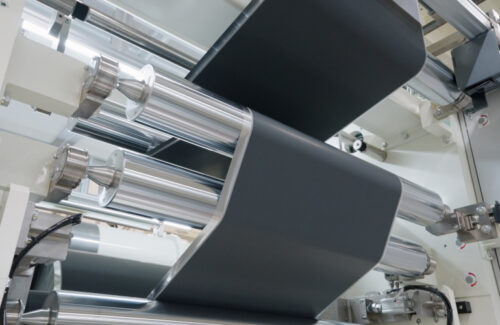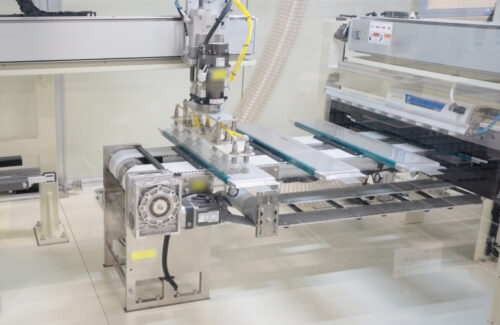LG Energy Solution (LGES) is now the country’s largest lithium-iron phosphate (LFP) battery cell manufacturer specifically for the grid-scale market. The Korean company began producing LFP cells at its new plant in Holland, Michigan, last month, and Solar Power World was able to tour the site this week and see production on two lines. A third line should be running by the end of the year, and the plant will eventually have an annual production capacity of 16.5 GWh of battery components for energy storage systems (ESS).
LGES has operated in Holland since 2012, first as an EV battery manufacturer under the “LG Chem” name. In 2022, the company announced a $1.4 billion investment to start ESS battery manufacturing at an expansion on-site. The decision to support an ESS build-out over EV was wise as the EV market of today faces waning customer demand and lessened federal support.
“ESS was the ugly duckling for some time for LG,” said Jaehong Park, CEO of LG Energy Solution Vertech, the stationary storage arm of LGES. “The financial performance of ESS in the past was difficult,” and EV was a much larger financial driver for the company. But now LGES sees more growth for ESS and already has four-times more ESS manufacturing capacity than last year, Park said.
That’s largely the main talking point for the industry: Regardless of the subsidies offered by the federal government, energy storage is here to stay. While the latest drafts of the congressional budget bill have made significant cuts to clean energy incentives established in the Inflation Reduction Act (IRA), energy storage has one small win. In the current bill language, energy storage projects would still have access to the IRA’s original investment tax credit (ITC) percentages, while solar project subsidies may receive an accelerated phase-down. It seems like an acknowledgment from Congress at just how important energy storage is becoming to America’s expanding electrical grid.
“There’s no short-term alternative to support the load increase,” Park said, noting that as more data centers and other large-electricity users come online, the country cannot build “traditional” fuel plants fast enough. Energy storage is the best-fit option to support intermittent energy sources (i.e., solar) to keep the grid running. “Without [supportive policy], ESS will slow but it will bounce back. It is necessary,” he said.
The LG Energy Solution plant in Holland is currently making just cells and will eventually begin assembling modules later this summer.
To make the cells, a mixing room takes raw materials and adds binders and solvents to make a slurry. Foil is coated with the slurry, which passes through various steps to roll it to the right thickness. One mono-cell consists of a cathode and anode layer combined with LGES’s safety-reinforced separator (SRS). Then 40 mono-cells are stacked with one extra anode layer, tabs are welded together and then they’re slid into aluminum pouches. The pouch is sealed, electrolyte gets injected and it soaks through the SRS. These pouches then get stacked into modules, which will then be containerized for grid-scale storage or residential applications.
Park said that the modules will be sent to LGES’s plant in Arizona to be assembled into LG Energy Solution-branded BESS. But soon, LGES will open an assembly plant outside Chicago to serve its Eastern-U.S. customers.
“We normally don’t do modules or containers,” Park said of LGES’s manufacturing area, but the company wanted to use its in-house expertise already developed through its EV partnerships to perform more ESS assembly in the United States.
Since LGES is making the battery cells on American soil, its BESS easily qualify for domestic content adders to the ITC, as currently written into law. Depending on how much of the IRA stays intact in the final budget bill, LGES BESS could be a hot commodity in the country.
U.S. battery manufacturing notes: Hithium has a 10-GWh LFP battery assembly plant in Texas, but it is not making the cells in the United States. Canadian Solar subsidiary e-STORAGE is building a 3-GWh LFP cell and module plant in Kentucky, but it is not yet complete. AESC has retooled its EV battery manufacturing plant in Tennessee to produce LFP cells for ESS (specifically Fluence), although the plant’s annual production capacity has not been revealed (previously estimated at 3 GWh for EV).





















